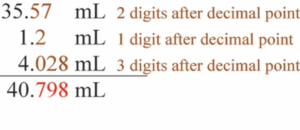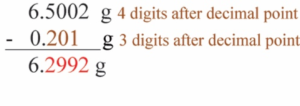We have discussed that in any measurement, the last number is always uncertain. The numbers used in these measurements are called significant figures of which all are certain except for last number. When properly used, significant figures represent the precision of a measurement. To read a volume of 12.5 mL, we know that the increments on the graduated cylinder were in in units of milliliters, and that the last number, 5, reflects an estimation between the 12 mL and 13 mL increments.
Identifying significant figures is quite easy when all the numbers in the measurement are non-zero.
For example, the measurement 25.46 g has 4 significant figures. In chemistry we often use measurements in calculations and we must report our answers using the correct number of significant figures. We will use the following rules to determine the number of significant figures that are in a measurement.
Rule 1. Non-zero Numbers: All non-zero numbers in a measurement are significant.
6,435 m contains four significant figures
2.1 g contains two significant figures
61.25 mL contains four significant figures
But notice that we did not include zeros in this rule. In measurements such as 140 cm and 0.0019 g, are the zeros considered significant or not? What we will see now is that sometimes zeros are significant and sometimes they are not considered significant. The following rules will help us to determine when zeros are included in the precision of the measurement, that is, when they are significant.
Rule 2. Sandwiched Zeros: When zeros occur between two non-zero numbers, they are always significant.
409 cm contains three significant figures( two significant non-zero numbers and one significant sandwiched zero)
8,009 g contains four significant figures (two significant non-zero numbers and two significant sandwiched zeros)
32,067 L contains five significant figures (four significant non-zero numbers and one significant sandwiched zero)
Rule 3. Leading Zeros: With no non-zero numbers to the left of a decimal point, leading zeros are zeros that come before the first non-zero number. We call them leading zeros.
0.045 nm contains two significant figures
(two non-significant leading zeros and two significant non zero numbers)
0.0000276 mL contains three significant figures (three significant non-zeros numbers and four non-significant leading zeros)
Let’s look a little closer at how leading zeros work. Consider the measurement 423 nm. We can readily see that this measurement contains three non-zero numbers, giving it three significant figures. Now, if we want to express this measurement in micrometers instead of nanometers, it would be 0.000423 m, and in units of millimeters it would be 0.000000423 mm. In this measurement, the precision is retained regardless of which units we use, and it will always carry the same three significant figures.
Rule 4. Trailing Zeros: Trailing zeros occur after the last non-zero number in a measurement, such as 3,500 g, 1.7500 cm, or 30 mL. Trailing zeros can be considered as significant or non-significant. The rule to determine if they are significant is as follows: If the trailing zeros occur after a non-zero number and to the right of a decimal point, they are significant. If there is no decimal point before them, they always are non-significant.
4.3500 cm contains five significant figures (three significant non-zero numbers and two significant trailing zeros that follow a decimal point)
2,300 g contains two significant figures (two significant non-zero numbers and two non-significant trailing zeros without a decimal point)
20 mL contains one significant figure (one-significant non-zero number and one non-significant trailing zero without a decimal point)
50. mL contains 2 significant figures (the zero is after a nonzero number and before the decimal point)
Sometimes a measurement without a decimal may contain trailing zeros of which one or more of the trailing zeros may actually be significant. How do we deal with this? Take for example the measurement 35,000 meters. Suppose that this distance was measured in such a way that it contains three significant figures, that is, the first three numbers including the first zero, are all significant, and the remaining two zeros are not significant.
The best way to express this measurement with the proper number of significant figures, that is the correct precision, is with scientific notation. We have learned that a number such as 35,000 can be written as 3.5 x 104. As it turns out, the numbers in the coefficient, in this case 3.5, are considered as significant. With this in mind, we can express the number 35,000 with three significant figures, as 3.50 x 104.
When adding or subtracting measurements involving decimals, we don’t look at the number of significant figures, but instead we look at the number of decimal places when determining precision. Take for example the simple operation of adding 35.57 mL, 1.2 mL, and 4.028 mL. We can readily see that 4.028 mL is the most precise measurement and the 1.2 mL is the least. Remember that the answer will need to reflect the precision of the least precise measurement which would be the 2.1 mL. So, how do we handle this?
Rule 1: When measurements involving decimals are added or subtracted, the number of decimal places in the answer will be determined by the measurement with the least number of decimal places.
Let’s add 35.57 mL, 1.2 mL, and 4.028 mL.

In this case, our answer can only have one digit after the decimal point. The answer is rounded to 40.8 mL.
When subtracting measurements, the same rule applies.

The answer is rounded to 6.299 g. When adding or subtracting measurements that do not contain decimals, the measurements are just added together. For example, if we add 53 mL to 425 mL we obtain 478 mL.
With multiplication and division of measurements, we don’t count decimal places. We consider precision by the number of significant figures, and again look for the least precise measure. The answer cannot have more significant figures than the measurement with the least number of significant figures. For example, if we divide 4.2543 g by 25 mL, our answer can only have 2 significant figures, because the measurement with the least number of significant figures has 2 significant figures. If we multiply 64.266 mL by 2.83 g/mL we get 182 g. Our answer can have no more than he measurement with the least number of significant figures which in this case is three significant figures. We were limited by the 2.83 g/mL (three sig figs).
We can add or subtract, multiply or divide the significant figures of measurements, but now let’s talk about combining these operations. When combining operations, we need to keep track of the number of significant figures that are to be retained from each calculation, but the answer is not rounded until the end. First, we need to know that when mixing multiplication (or division) with addition (or subtraction) in a calculation, the multiplication (division) is performed first followed by the addition (subtraction). To make things easier, certain parts of the calculation are sometimes put into brackets or parentheses, and these operations are performed first. After we obtain our calculator answer, we then go back and determine the number of significant figures to retain in the answer. The best way to understand this with an example.
\(\displaystyle3.21\times\left(\frac{2.68-0.994}{6.77+8.223}\right)\)First, perform the operations inside the parenthesis. Keep track of significant figures. Underline the last digit that can be kept.
\(\displaystyle3.21\times\left(\frac{1.6\underline{8}6}{14.9\underline{9}3}\right)\)For both the addition and subtraction, we can only keep two digits to the right of the decimal point. Next, we can divide the numbers inside the parenthesis. The numerator has 3 significant figures and the denominator has 4 significant figures. Because we are dividing, we can only retain 3 significant figures.
\(\displaystyle3.21\times\left(0.11\underline{2}452478\right)\)Next, we multiply. Both terms have 3 significant figures, therefore, our answer must have 3 significant figures.
\(\displaystyle3.21\times\left(0.11\underline{2}452478\right)\;=\;0.36\underline{0}972454\;=\;\mathbf{0.361}\)
Do not round until you have finished the calculation. You can keep track of the significant figures by underlining the last digit that can be kept.
Click here for the Significant Figures Worksheet
Take the Quiz on Significant Figures.
Go Back to Matter and Measurement in Chemistry
Back to Study Guide List for General Chemistry I
Go To Home Page
